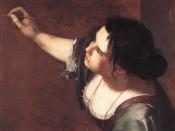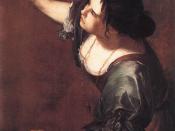A woman painter to be the first to gain international fame is quite an accomplishment during the 17th century. Artemisia Gentileschi was an Italian painter during the Baroque period. Artemisia was one of Caravaggio's followers, helping to spread the caravaggesque style. She also used a style of baroque naturalism and tenebrist effects. "Tenebrism, forms emerge from a dark background into a strong light that often falls from a single source outside the painting; the effect is that of a modern spotlight" (Stokstad, 736).
"Throughout her life, Artemisia painted images of heroic and abused women-Judith, Susanna, Bathsheba, Esther- and she also became a famous portrait painter" (Stokstad, 738). She was well known for her Self-Portrait as the Allegory of Painting, in 1630. "The image of a woman with palette and brushes, richly dressed, and wearing a gold necklace with a mask pendant comes from a popular source book for such images, the Iconologia, by Cesare Ripa (1593), which maintains that the mask imitates the human face, as painting imitates nature" (Stokstad, 738).
Artemisia's self-portrait is painted in oil on canvas; the size is 38 x 29 inches. It is a wonderful painting of hers, very soft and free, and the lighting of her pale skin in contrast with the dark background colors. You can even tell from the detail of her sleeve, and from its shine, it was a silky material. The title, Self Portrait as the Allegory of Painting, was speaking in terms of herself as an allegory, mean "an image (or images) that symbolically illustrates an idea, concept, or principle, often moral or religious (Stokstad, Glossary 1). This painting is now located at the Royal Collection, Windsor Castle in Windsor, England.
Artemisia Gentileschi was born in Rome, on July 8, 1593, and died in 1653. She was inspired...


